The 2022 updates to the Wahoo Elemnt Roam V2 improve what was already one of the best bike computers available.
On the outside, they’re slight, but inside there’s more data storage, a more colourful display and new functionality including profiles for climbs on pre-mapped routes.
The touchscreen-free button interface is less of an impediment than it might seem, although more complicated operations can become fiddly.
Fortunately, the excellent smartphone app means you can do much of your configuration and ride management on a touchscreen.
Wahoo Elemnt Roam V2 details and specifications
At first glance, you’d be hard-pressed to tell the difference between the latest Wahoo Elemnt Roam and the original Elemnt Roam. They’re identical in size and shape at 89x55x18mm, with a slight weight increase from 96g to 100g, or 140g including the unit-specific plastic out-front mount.
The size of the non-touchscreen hasn’t changed either at 2.7in diagonal, although the colour range has been upped from 8 to 64 colours.
The number of pixels hasn’t changed at 240x400, comparable to Garmin Edge bike computers but a lot less than the Hammerhead Karoo 2. The screen is matt-finished, making it easy to read in bright sunlight, and the ambient light sensor ensures it stays legible.
There’s the same array of LEDs at the side of the screen and another at the top as on the older Elemnt Roam, both of which can show red, green, blue, yellow or white, depending on the data to display.

The shape of the three buttons at the bottom of the face of the Wahoo Elemnt Roam has changed from concave (recessed) on the old model to convex (pronounced) on the new one.
It makes them a little easier to use, but also means they're less prone to collecting dirt and sweat as you ride. The one left-side button and two right-side buttons are slightly larger too.
Other than that, the only visible change is from a matt to a gloss bezel around the upper sides of the unit. Under the rubber bung on the base, there’s now a USB-C rather than Micro-USB charging port.
The new Elemnt Roam has the same neatly integrated plastic out-front mount. It clicks securely into this with a slightly-under-quarter turn, with the mount making a smooth transition into the Elemnt Roam’s body.
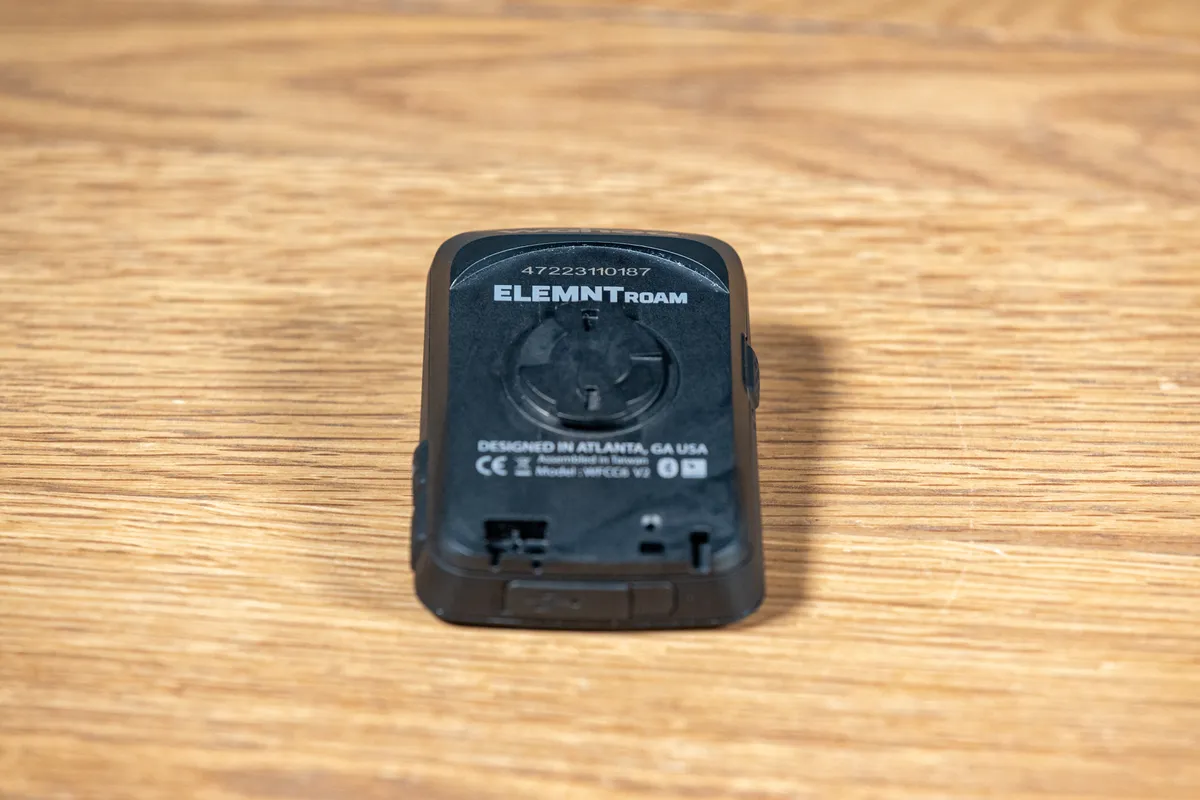
This looks a lot more streamlined than Garmin’s standard quarter-turn mount, even if Wahoo doesn’t claim any specific aero benefits. There’s a stem mount in the box too.
As with the old model, you can screw the computer into the out-front mount so it can’t be removed.
This is a cunning trick that means it counts towards the overall bike weight for UCI races. More prosaically, it makes it harder for someone to walk off with it at the coffee stop.
Size-wise, the Wahoo Elemnt Roam is smaller than both the Garmin Edge 1040 and the Hammerhead Karoo 2, although it’s larger than the Garmin Edge 530 and 830.
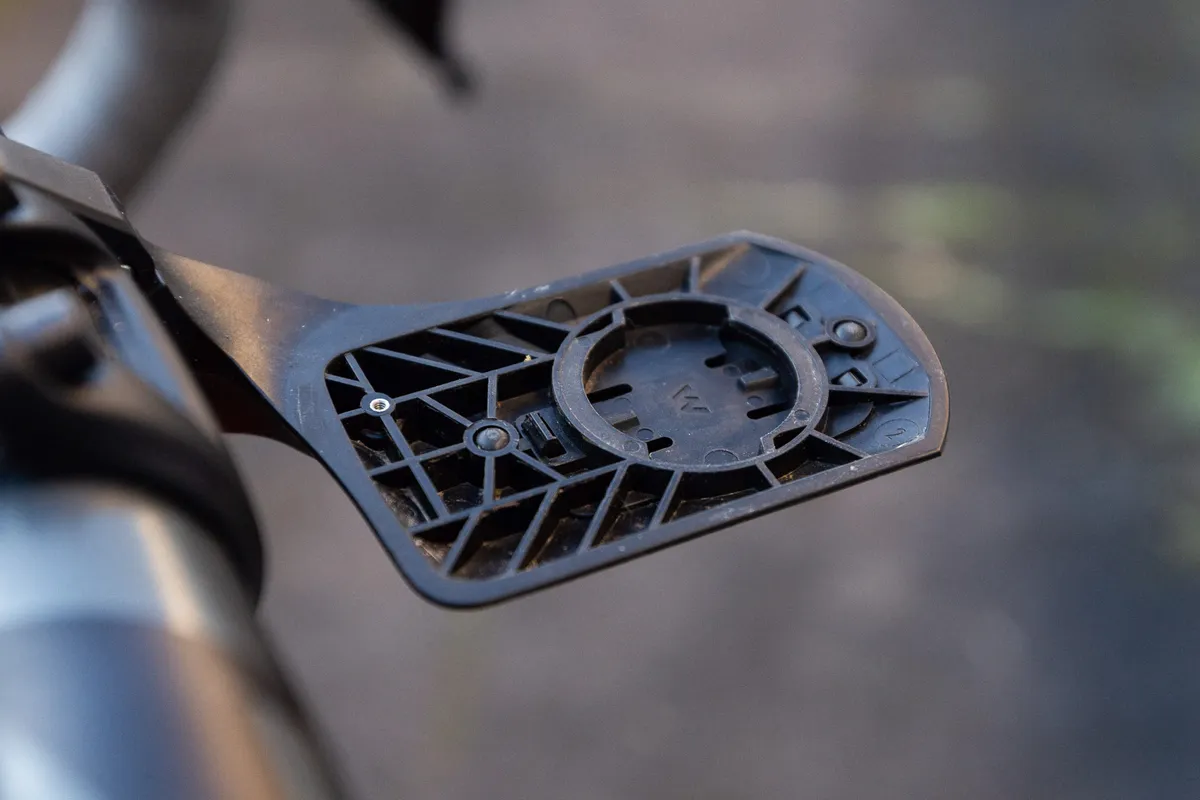
There are more changes under the bonnet of the new Wahoo Elemnt Roam than there are on the surface, including an increase in memory from 4GB to 32GB, which matches Garmin’s top-end devices and the Hammerhead Karoo 2.
Wahoo says that, as well as giving you more space to store ride data, this enables easier map management, with the ability to store larger areas. Wahoo also includes more information on its base maps.
Wahoo has added dual-band GPS to the Elemnt Roam, which should provide a more accurate, more reliable GPS fix. It’s something the Garmin Edge 1040 offers too, but that’s a significantly more expensive unit.
The Wahoo Elemnt Roam supports Bluetooth and ANT+ for connecting to your phone, and peripherals such as a heart rate monitor or a power meter. There’s also WiFi, which enables automatic uploading of routes before a ride and workouts once you get home.
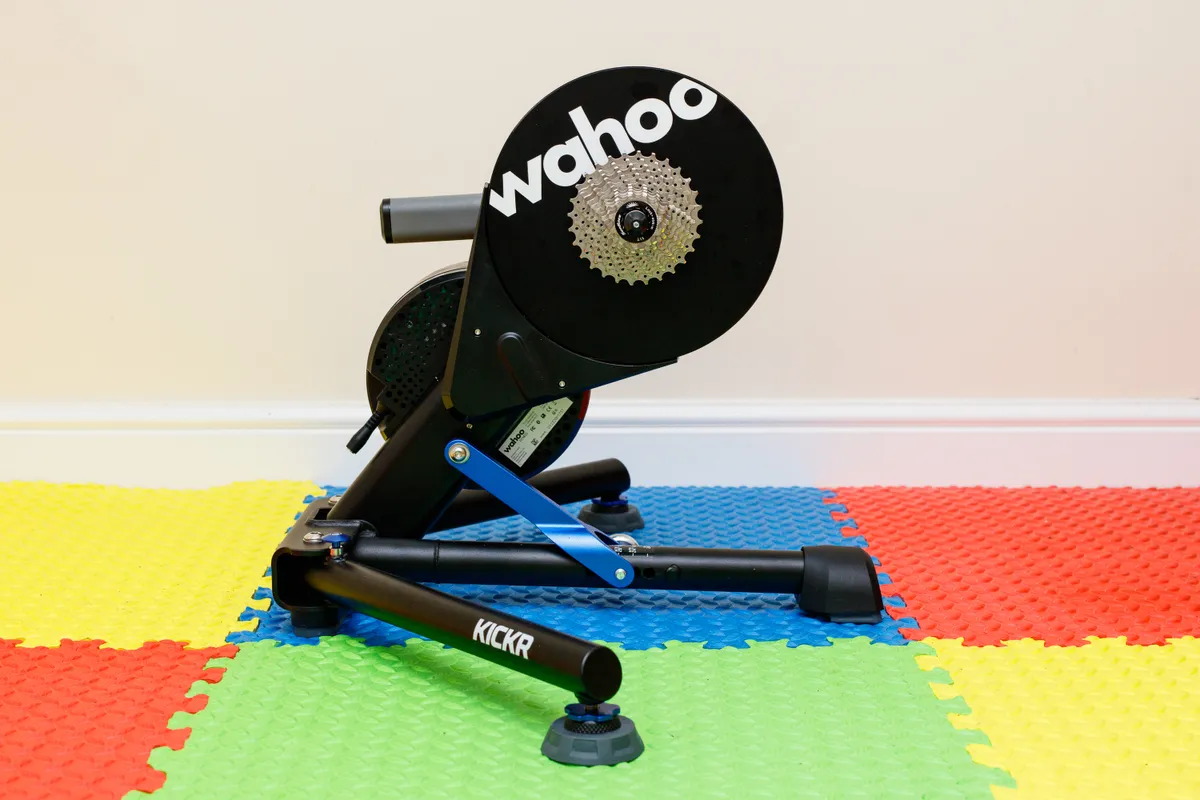
Wahoo also majors on indoor workouts and you can use the Elemnt Roam to control smart trainers such as the Wahoo Kickr V6 and Kickr Core, or those from other brands that are compatible with BLE or ANT+ FE-C.
It has a range of workouts on-device, and you can add to those yourself. Wahoo has also made it so that you can take on a workout both indoors and outdoors.
Wahoo Elemnt Roam V2 vs Wahoo Elemnt Bolt V2
The Elemnt Roam V2 sits alongside the Wahoo Elemnt Bolt V2 in the company's range.
Where the Bolt is aimed at performance-minded riders after a compact, streamlined unit (while retaining a colour screen and mapping/navigation), the Roam is a larger unit, with a bigger screen and, as a result, more focus on telling you where to go.
As well as a bigger display (2.7in compared to the Bolt's 2.2in), the Roam has a better-claimed battery life (up to 17 hours versus 15 hours), dual-band GPS, and a built-in accelerometer and gyroscope/compass.
You can also read our Wahoo Elemnt Bolt V2 review for more on how that computer performs.
Wahoo Elemnt Roam V2 setup
Wahoo has retained the easy setup from the previous model. Switch on the unit, choose your language and a 3D barcode prompts you to download the phone app from Google Play or the Apple App Store and pair it with your phone.
From then on, there’s a wizard on the phone that guides you through setup.
It’s very simple and you can also use the phone to change things on-device later via a well-designed touchscreen interface rather than having to scroll through menus on-device, although that’s still an option as well. Changes on the phone are reflected immediately on the computer.
The phone app will search for and connect to the computer automatically when both are running. It gives you your ride history, enables you to choose a route to ride via the phone’s touchscreen, pick a planned workout, and hook up the usual array of sensors.
You can link up your Wahoo Elemnt Roam to the best cycling apps, such as Strava and Komoot, and it supports live tracking by third parties if you’ve got your phone with you. You can also opt to show your location to other Elemnt users and see theirs as you ride, which is useful for group rides.
Another useful new group feature is public route sharing. Rather than having to mail GPX files or hunt for a route in someone’s profile, you can broadcast a route to other Wahoo users around you for them to pick up.
There’s also the new option to link to a Supersapiens continuous blood glucose monitor and have your sugar levels and a trend arrow displayed as you ride.
This is claimed to help you manage your in-ride feeding and avoid running out of carbohydrate fuel mid-ride. It’s not a cheap add-on though, with each glucose monitor patch costing €75 and lasting for 14 days before it has to be replaced.
It seemed to take a little time for the Elemnt Roam to pick up a reading from the Supersapiens patch at the start of a ride, although that’s not the point at which your blood sugar levels are likely to be important to track.
Wahoo Elemnt Roam V2 ride data
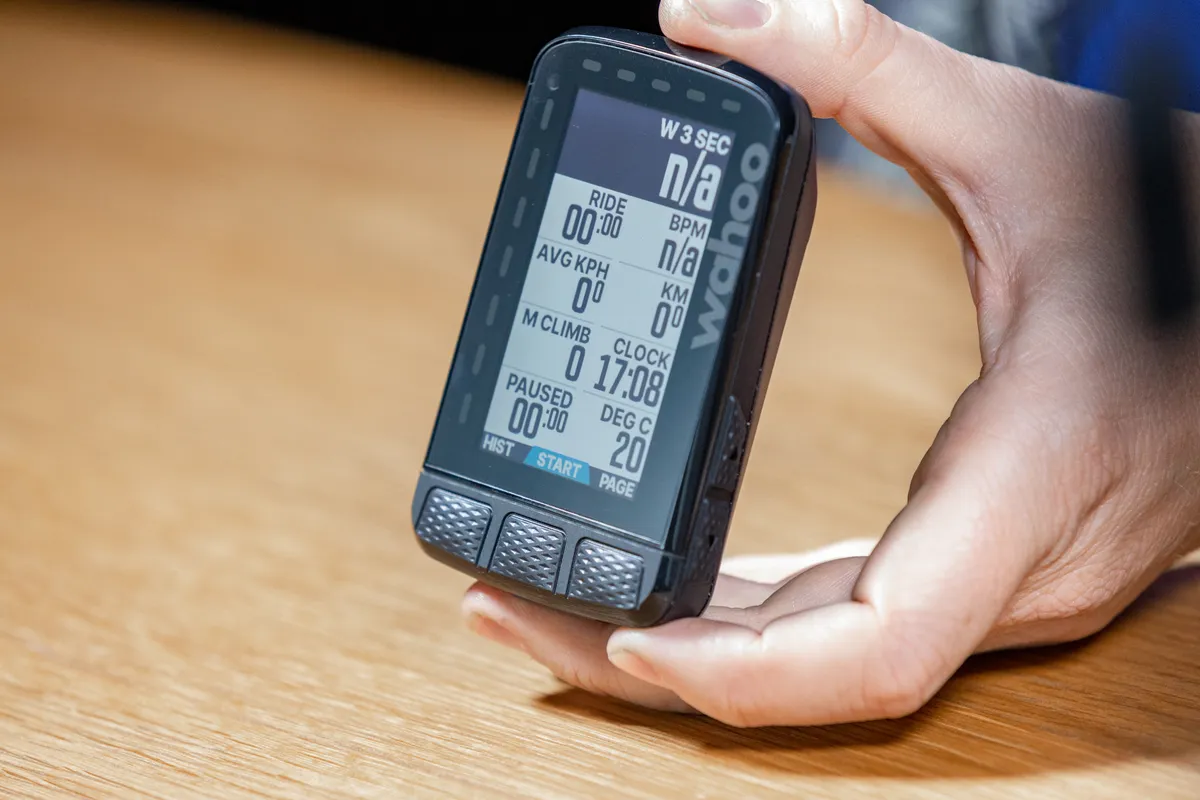
As is usual with bike computers, you can configure what you see on-screen, with up to 11 fields displayed, which you rank from most to least important, dragging and dropping to reorder or replacing them as you see fit.
Even with 11 data fields displayed, the screen font makes them relatively easy to view. But Wahoo’s most cunning feature is its ‘Perfect Zoom’, controlled via the two buttons on the right side of the unit.
Perfect Zoom works really well for ride data. Hit the upper side button and you reduce the number of fields displayed and increase their size. You can display just your single highest-priority data item, such as speed, if you want. The lower side button has the reverse effect.
That makes it easy to tailor your display on the fly to see a smaller or larger selection of data fields, without needing to fiddle with screen and field definitions in the phone app. The Elemnt Roam remembers the zoom level you’ve set between uses and powers up showing the same number of fields.
You can only scroll in one direction through the screens as you ride, using the right-hand button. It’s easy enough but means if you hit the button one too many times you’ll need to go all the way round again. In practice, with a small number of screens displayed, I didn’t find this a problem.
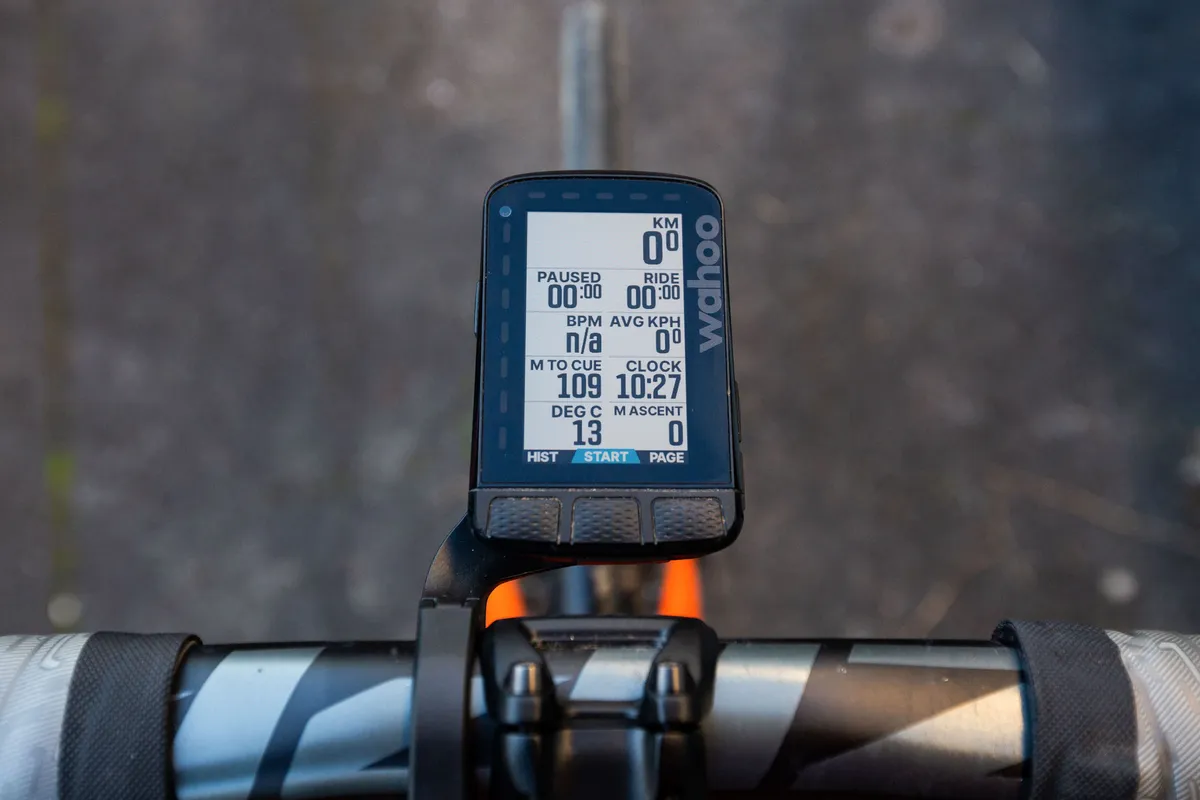
Perfect Zoom works on the map display too, with the upper button zooming in and the lower zooming out. Your current position is held near the bottom of the screen, so that you get to see more of the road ahead. It’s a lot less fiddly to use while riding than trying to pinch a map or hit a zoom button on a touchscreen.
You can also pan and zoom on the map. This is significantly more fiddly to do than on a touchscreen though, using all five buttons to move around the map and zoom in on a specific area.
The base map has major and minor roads mapped. Off-road paths are also shown comprehensively, at least where I live, and a local trail centre was mapped too.
Not all off-road paths shown are rights of way, though, and you can’t differentiate between those that are and those that aren’t. Other features such as bodies of water are shown in pale blue and wooded areas are shown in faint green, which can be difficult to differentiate.
Don’t expect a riot of colour from the new 64-colour screen though. Mostly, the display is monochrome. Wahoo says this is deliberate and it only uses colour where it helps to pick out more significant data, such as which heart rate or power zone you are in.
The LED arrays work well to take some of the pressure off the fairly small screen. The side array can be configured to show speed, power or heart rate (or be switched off entirely), while the top array can be used to show everything from an approaching Strava Live segment to an incoming text message.
It’s also used to indicate turns.
Wahoo Elemnt Roam V2 mapping and navigation
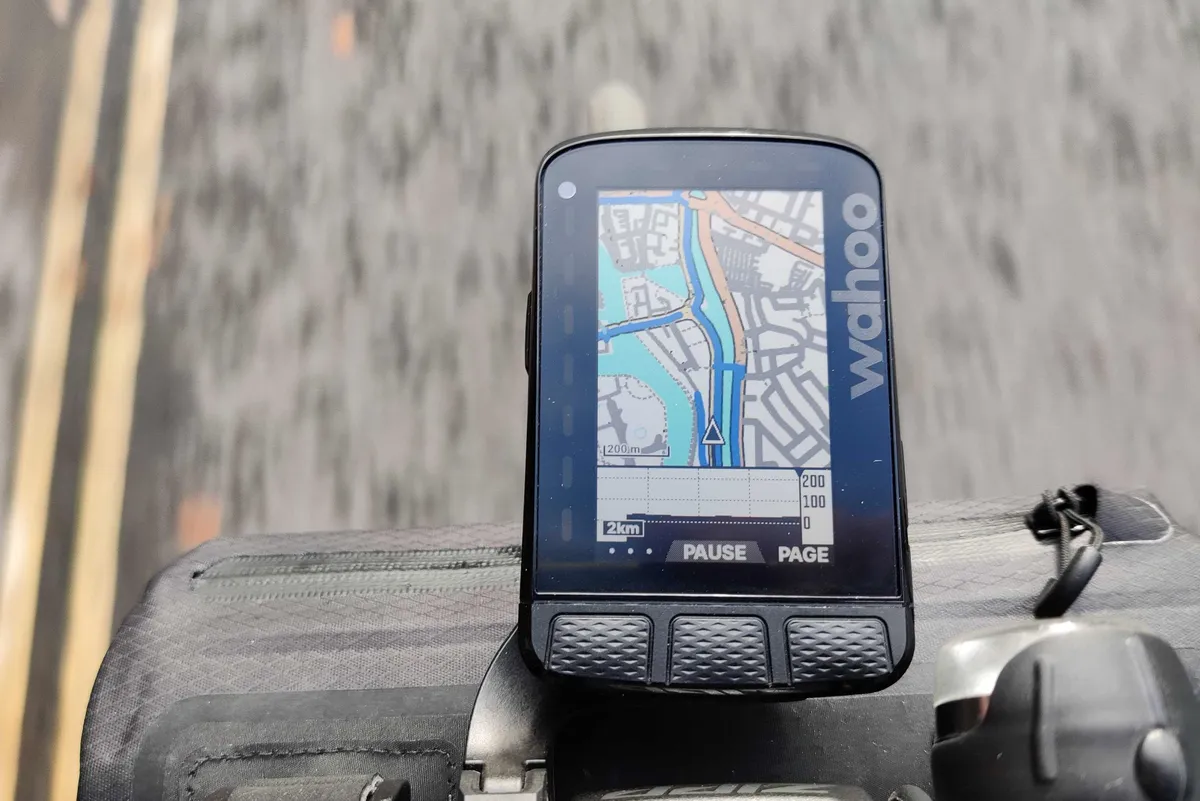
If you want to follow a route you’ve mapped out elsewhere (such as on Strava or Komoot), if you’ve linked your accounts and you’re in WiFi range or have the device linked up to your phone, your new route will appear automatically in your list of routes on the Wahoo Elemnt Roam. It’s then just a case of following it.
You can also select a destination on the device. This is where the lack of a touchscreen gets a little more awkward, because you need to scroll around and zoom with the side buttons on the device.
Although this isn’t too difficult, it’s not as polished as being able to scroll and point on a screen. There’s also the option to save a location and select this, which is a little easier.
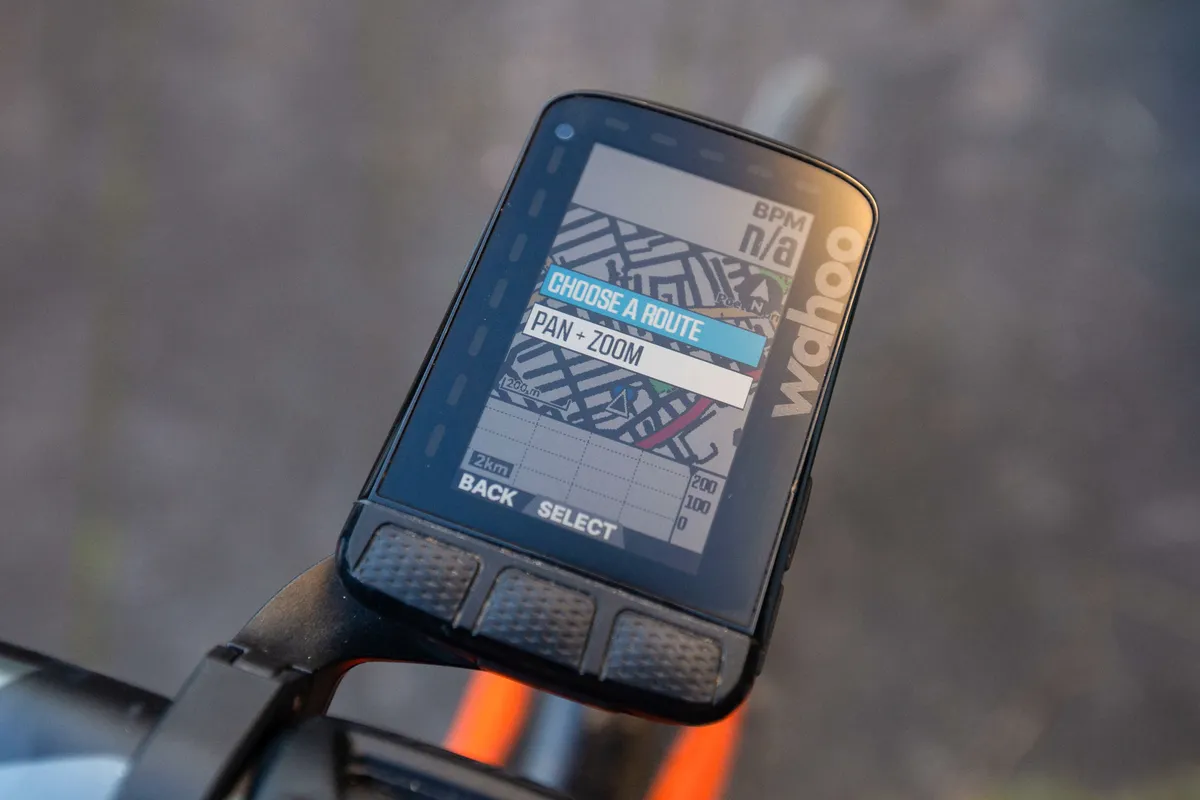
Ride your route and the navigation is clear. The maps have a good amount of detail, but not so much that you’re swamped. The Perfect Zoom buttons really help here with zooming in and out on your map.
The LED arrays, turn instructions on-screen and an audible alert ensure you don’t miss a turn by indicating it well in advance. You get a second LED alert at the turn, but despite the more precise GPS fix that dual-band GPS should allow, this often appeared after I’d already made the turn. Once you’ve turned, the LEDs flash green.
Miss a turn and the LEDs will flash red. For simple rerouting problems, the Roam will quickly calculate a new route and guide you back on course, with the LEDs flashing green to show the revised route has been calculated.
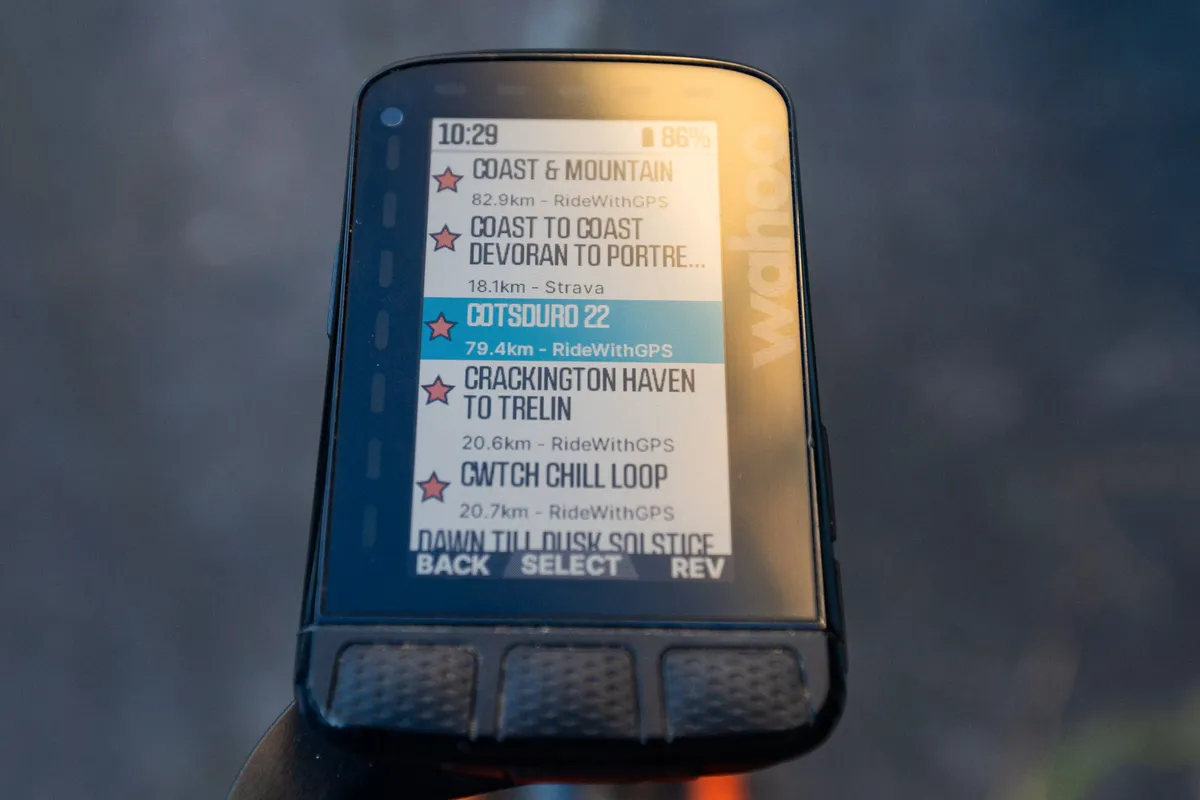
My most tricky rerouting problem outfoxed the Elemnt Roam, though. This involved skipping a left turn on a route that will take you onto a road parallel to the off-course road.
The two roads run parallel to each other roughly 1.5km apart. There are two roads that link them around 2km and 3km further on, with a series of cul-de-sacs before you reach these.
The Roam kept indicating a turn down the cul-de-sacs, and when I followed one it sent me on a square back to the main road, instructing me to retrace my route back to where I’d left the mapped route.
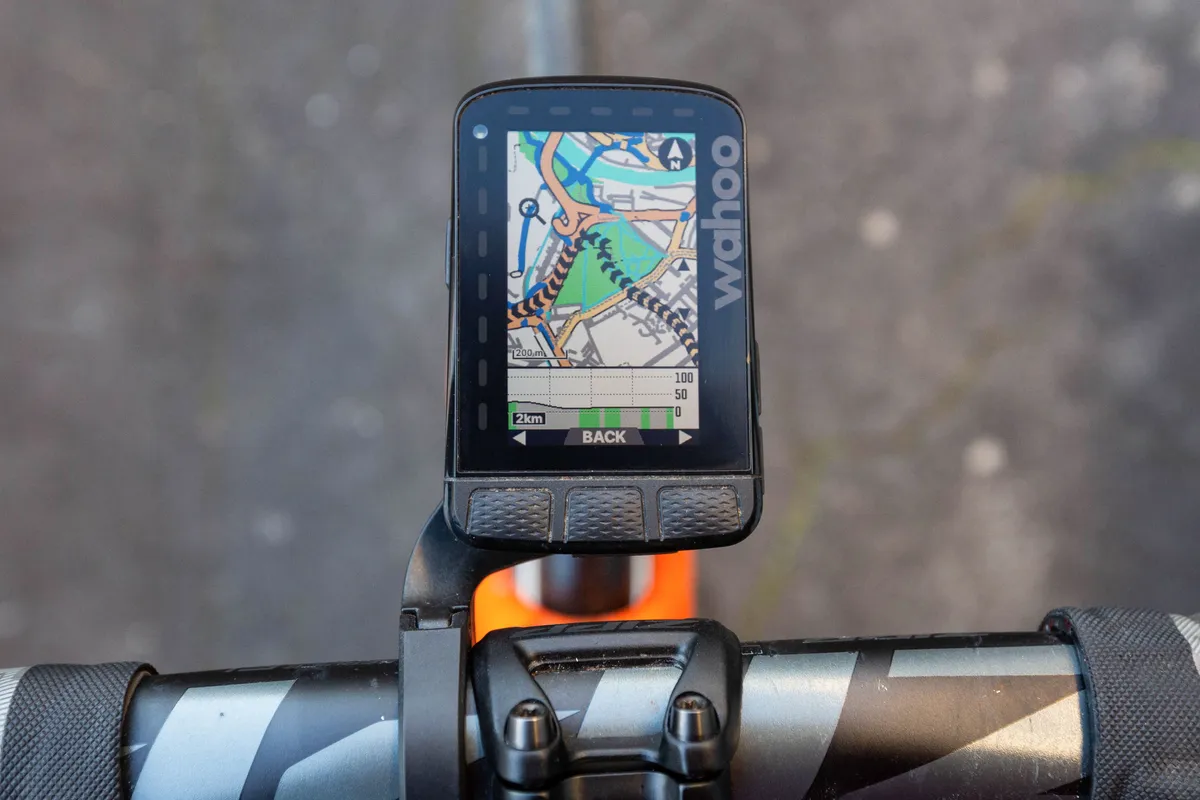
When I ignored this, it did indicate the connecting roads, but when I rejoined the mapped route, it initially asked me to turn back on myself, rather than continuing in the correct direction.
The exercise is a little contrived and some other GPS devices just give up when challenged like this. A Garmin Edge 1040 Solar and a Hammerhead Karoo 2 both managed the rerouting successfully.
Wahoo Elemnt Roam V2 climb data
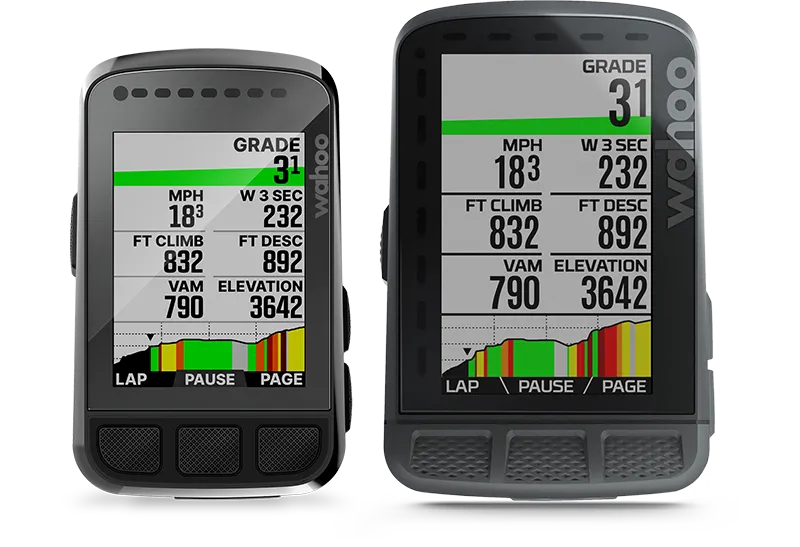
Wahoo has just added Summit Segment climb profile data to the Elemnt Roam, giving you a profile for climbs on a pre-mapped route and tracking your progress as you tackle them. It’s functionality that many cycling computers, including the whole Garmin range, have offered for ages, so Wahoo is playing catch-up here.
Wahoo’s Summit Segment functionality works rather differently from its rivals though. Whereas Garmin, Hammerhead and others give you a gradient profile for a whole climb, if there’s a short flat section in the middle, Wahoo breaks the climb into separate components.
Wahoo’s climb functionality also seems to be more sensitive, pulling up a climb profile for slighter gradients than other computers.
It’s not better or worse than the way other brands do it, although it means you don’t get the full picture of how much climbing you’re in for at the start of an ascent.
That could be more frustrating if you’re taking in an alpine climb, but the Roam did treat a couple of climbs I mapped in the Dolomites (which include downhill and flat-ish sections) as a single ‘Summit Segment’.
What I liked was how Wahoo shows your progress. Whereas most computers give you a marker for where you are on a climb, Wahoo blacks out the part of the climb you’ve already covered. This makes it a lot easier to see quickly where you are on the ascent when you’re slogging it out on a steep pitch.
On the other hand, it's less apparent whether you’ve done the steepest parts already or if they’re yet to come.
You get data displayed on the climb screen for gradient as well as remaining distance and (somewhat discouragingly, in my case) estimated time to the top.
Wahoo Elemnt Roam V2 battery life
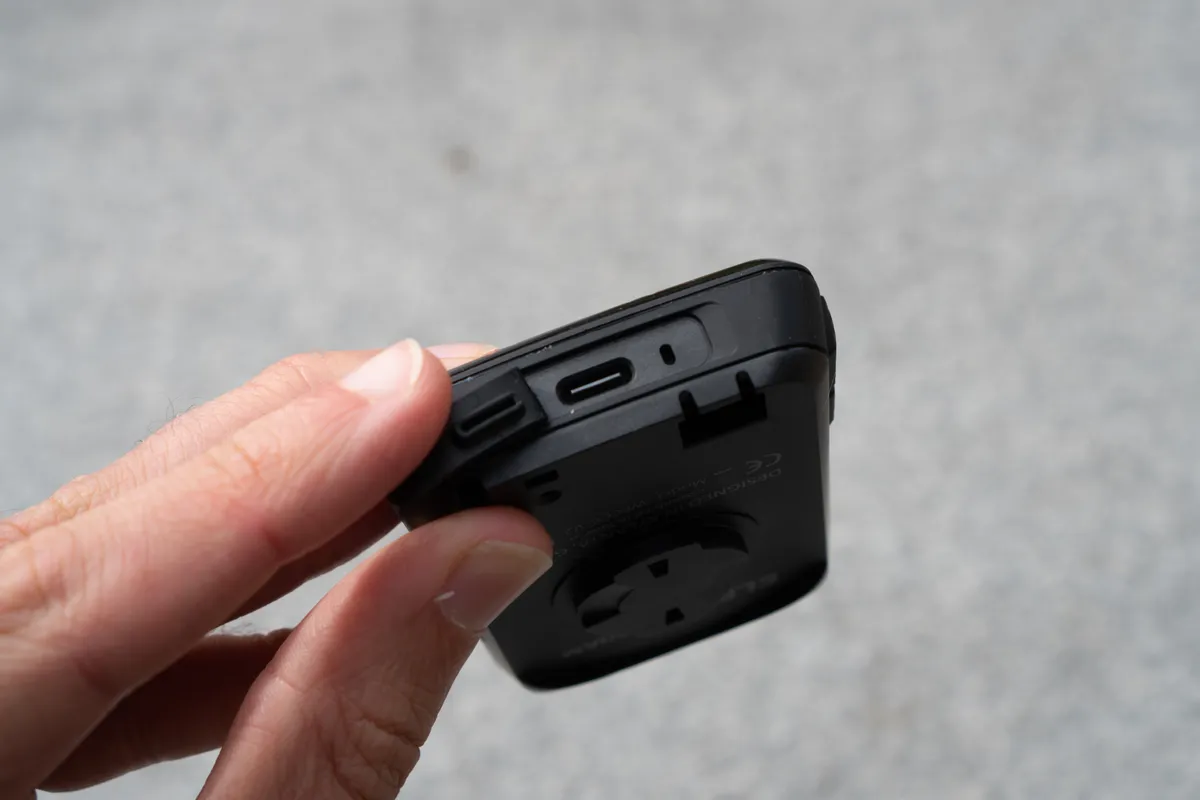
The Wahoo Elemnt Roam’s battery life is best described as middling. It’s not as good as the Garmin Edge 1040 Solar or the Bryton Rider S800, but at 17 hours it comfortably exceeds that of the Hammerhead Karoo 2 and is just a little less than Garmin’s mid-range units.
In my tests, it came close to achieving the claimed 17 hours.
For most riders, that’s going to be enough in most circumstances, although if you like to take on multi-day adventures or will be somewhere where you can’t recharge, you might find it limiting.
When you do need to recharge, the Roam has a USB-C connector, so it’s quick to charge up. I got a 50 per cent boost in under an hour.
Wahoo Elemnt Roam V2 bottom line

The latest-version Wahoo Elemnt Roam is an evolution of the previous Elemnt Roam. Wahoo has made some useful upgrades to memory and functionality, which make for a better user experience and easier data management.
The phone app makes the Roam easy to use, despite the absence of a touchscreen on the device. The lack of a touchscreen is more of a hindrance if you want to do things on-device though, meaning you’ll want to take your phone with you when you ride.
Overall, the Wahoo Elemnt Roam V2 remains competitive versus the best cycling head units available today.
Product
| Brand | Wahoo |
| Price | A$599.95, €399.99, £349.99, $399.99 |
| Weight | 100g |
Features
| Strava live segments | yes |
| Rechargeable battery | yes |
| Turn by turn navigation | yes |
| Screen type | colourlcd |
| Connectivity | antPlus |
| Connectivity | antPlus_fe_c |
| Connectivity | ble |
| Connectivity | wifi |
| Maps | Yes |
| Dimensions | 90.5mm tall x 59.5mm wide x 20.5mm deep |
| Battery life | 17 hours |
| Water resistance | IPX7 |
| Screen dimensions | 2.7” |
| Display resolution | 240 x 400 pixels |
SQUIRREL_13076440
